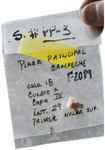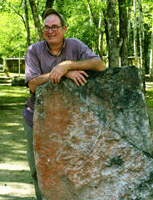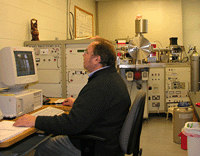
Posted on 04/14/2007 8:25:48 AM PDT by blam
Written in Bone
Volume 60 Number 3, May/June 2007
by Brenda Fowler
How radioactive isotopes reveal the migrations of ancient people

A molar from the city of Campeche in Mexico (Courtesy Douglas Price)
In the late thirteenth century, drought ravaged the American Southwest, withering the corn, squash, and beans upon which ancient inhabitants relied for survival. Across the region people abandoned their homes in a desperate search for arable land. Some were lucky enough to find a moist Arizona valley where they built a settlement now known as Grasshopper Pueblo.
At its peak, the pueblo consisted of 500 rooms housing hundreds of families. Archaeologists were puzzled by the differing architecture, pottery styles, and burial traditions within the pueblo, leading them to speculate that the drought must have been so severe that people from several different cultures were forced to live together in one of the few places where food would still grow. While the pottery strongly hinted at the disparate origins of the population, there was no way to test that idea.
Enter archaeologist T. Douglas Price, geochemist Jim Burton, and their colleagues from the Laboratory of Archaeological Chemistry at the University of Wisconsin in Madison. In the late 1980s, Price and Burton learned of a new technique that measured the ratio of strontium isotopes in human bone, revealing how an individual had migrated. One of Price's students, Joseph Ezzo, had worked at Grasshopper Pueblo and was eager to try the new technique there.

Doug Price rests after chasing snails at the Maya city of Calakmul. Snail shells help establish an area's strontium baseline. (Courtesy Douglas Price)
Most rocks carry a small amount of the element strontium (Sr). All elements have different forms, or isotopes, and the ratio of 87strontium and 86strontium isotopes varies according to local geology. Generally, older rocks have accumulated higher amounts of 87Sr in relation to 86Sr. Humans and other animals absorb strontium through the water and plant foods they consume, creating a chemical signature of the local geology within their bodies.
What makes strontium isotope analysis especially interesting for archaeologists is that the parts of the human body where the isotopes collect--tooth enamel and bone--are formed at different stages of a person's life. Tooth enamel forms in a child's first few years and does not change as a person ages, so the strontium isotope ratio of enamel matches the geology in the area where a person spent his or her childhood. By contrast, the strontium in bone gradually changes over a seven- to ten-year period and reveals the region where people spend the last decade of their lives. By matching the strontium isotope ratios in bones and teeth to those in specific geographic regions, Price is able to tell whether a person migrated between childhood and death, and sometimes can even pinpoint where the person was born.
When Price and his team began working at Grasshopper Pueblo, only two other groups had tried strontium analysis. "I guess my [first] thought was 'is this really going to work?'" says Price, who founded the Laboratory for Archaeological Chemistry nearly 20 years ago.

Paul Fullagar of the University of North Carolina sits at the controls of the thermal ionization mass spectrometer he uses to analyze strontium isotope ratios in tooth and bone samples. (Courtesy Douglas Price)
North-central Arizona is a mosaic of geological deposits, so Price believed the individuals buried at Grasshopper Pueblo would show distinctive isotopic signatures if they had migrated across the region. Initially, Price's team studied teeth and bones from six individuals--three of whom, including two from the earliest burials at the site, had strontium isotope ratios similar to the local geology. But the ratios of three others revealed that they had grown up far from Grasshopper, perhaps somewhere to the north. The results suggested that Grasshopper had been settled by several cultures.
"We were lucky starting with Grasshopper because it was a really good situation--geologically very diverse and where several cultures came to the same place and started a pueblo," says Price.
Since the early days at Grasshopper, Price and Burton have refined their isotopic analysis techniques. They are currently involved in about 10 projects, mostly in Mesoamerica, the North Atlantic, and Northern Europe. One of their most prominent studies addressed the origins of Yax K'uk Mo, who founded a dynasty in the Maya city of Copán in western Honduras. According to inscriptions, he arrived in Copán in A.D.. 426 when it was little more than a village. Some archaeologists had believed he came from Teotihuacán, an influential city in the Mexican highlands. After the king's tomb was discovered deep under a temple mound, Price's analysis revealed that he was born much closer to Copán, possibly in the Peten, the jungle of northern Guatemala.
"When I started this work with the isotopes, I didn't think people moved around very much. I thought they were pretty sedentary," says Price, "and I have changed 180 degrees as a result of this work. Almost every place we look we see a lot of mobility."
Brenda Fowler is the author of Iceman: Uncovering the Life and Times of a Prehistoric Man Found in an Alpine Glacier.
GGG Ping.
Ah, yes. The conjoining of nuclear science, analytical chemistry, geology, and archaeology. Ain’t science wonderful.
Which assumes radioactive decay and radioactive carbon was always at a constant level and decayed at the same rate as today.
We know from studying the claims of "global warming" that these things were always fluctuating,(plus other decay rate discoveries of late) so to assume the results of these calculations are correct, and then use them to "map out" migrations of a people who probably aren't as "ancient" as hoped, would be far from conclusive.
Let the show begin :o)
The article is about strontium, not carbon.
Please FREEPMAIL me if you want on or off the
"Gods, Graves, Glyphs" PING list or GGG weekly digest
-- Archaeology/Anthropology/Ancient Cultures/Artifacts/Antiquities, etc.
Gods, Graves, Glyphs (alpha order)
I believe a similar analysis from archeological specimens has shown that corn culture moved north from Mezo America into the northern US. Similarly other artifacts like beads/seashells from MezoAmerica have been found in places like Chaco Canyon.
It’s always possible that this was a natural evolution during climatic change, but another explanation using Occam’s Razor is that there was some inter-tribal communication and trade going north and south.
Hah, I already saw this stuff on “Law & Order” :)
Tests Reveal Amesbury Archer "King Of Stonehenge' Was A Settler From The Alps
"Tests were carried out on the Archer’s teeth and bones and on the objects found in the grave, which included two gold hair tresses, three copper knives, flint arrowheads, wristguards and pottery. They show that he came from the Alps region, and that the copper knives came from Spain and France. This is evidence of the wide trade network that existed in the early Bronze Age. The gold dated to as early as 2,470BC, the earliest gold objects found in Britain."
Hmm. A settler from the Alps. I bet he was the guy that shot Otzi and left him on the glacier to die.
Seriously, the more we explore our ‘primitive’ ancestors, the more we find that some societies were fairly sophistcated about trade and commerce over long distances, much more interaction than had been theorized before.
There are other isotopes useful besides C14 (you'll note that the article is talking about strontium isotopes). And the isotopes don't "necessarily" have to be radioactive. Ratios of stable isotopes also are useful for obtaining various information.
"We know from studying the claims of "global warming" that these things were always fluctuating,(plus other decay rate discoveries of late) so to assume the results of these calculations are correct, and then use them to "map out" migrations of a people who probably aren't as "ancient" as hoped, would be far from conclusive."
Sure, but there are (at least for C14, but probably for other isotope systems as well) ways to "calibrate out" those kinds if variations. In the case of C14, it is done by measuring the C14 content of tree rings, and counting the tree rings to actually count years (dendrochronology) for the ring of that C14 content. That gives an actual corrected calibration curve for C14 content.
And yes, there's still a margin of error involved, but it is small enough to deliver useful data.
Unlike the dynamic, cyclic phenomenon like solar emissions, orbital variations, and volcanic activity which can affect global temperature and change radioactive decay is a linear function controlled by the laws of physics. "As it was in the beginning, is now and ever shall be".
|
|
|||
Gods |
Just updating the GGG info, not sending a general distribution. |
||
|
· Discover · Nat Geographic · Texas AM Anthro News · Yahoo Anthro & Archaeo · Google · · The Archaeology Channel · Excerpt, or Link only? · cgk's list of ping lists · |
|||
Disclaimer: Opinions posted on Free Republic are those of the individual posters and do not necessarily represent the opinion of Free Republic or its management. All materials posted herein are protected by copyright law and the exemption for fair use of copyrighted works.